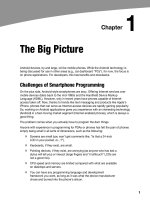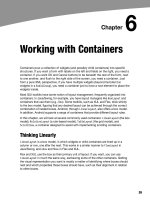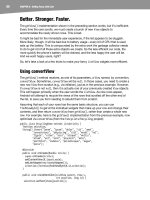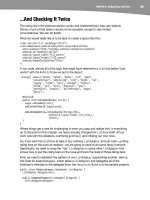Lập trình Androi part 56 ppsx
Bạn đang xem bản rút gọn của tài liệu. Xem và tải ngay bản đầy đủ của tài liệu tại đây (239.78 KB, 7 trang )
CHAPTER 38: Handling Platform Changes
362
Handling API Changes
The core Android team has generally done a good job of keeping APIs stable, and
supporting a deprecation model when they change APIs. In Android, being deprecated
does not mean it is going away—just that its continued use is discouraged. And, of
course, new APIs are released with every new Android update. Changes to the APIs are
well documented with each release via an API differences report.
Unfortunately, the Android Market (the primary distribution channel for Android
applications) allows you to upload only one APK file for each application. Hence, you
need that one APK file to deal with as many Android versions as possible. Many times,
your code will “just work” and not require changing. Other times, though, you will need
to make adjustments, particularly if you want to support new APIs on new versions while
not breaking old versions. Let’s examine some techniques for handling these cases.
Detecting the Version
If you just want to take different branches in your code based on version, the easiest
thing to do is inspect android.os.VERSION.SDK_INT. This public static integer value will
reflect the same API level as you use when creating AVDs and specifying API levels in
the manifest. So, you can compare that value to, say, android.os.VERSION_CODES.DONUT
to see whether you are running on Android 1.6 or newer.
Wrapping the API
So long as the APIs you try to use exist across all Android versions you are supporting,
just branching may be sufficient. Where things get troublesome is when the APIs
change, such as when there are new parameters to methods, new methods, or even
new classes. You need code that will work regardless of Android version, yet lets you
take advantage of new APIs where available.
There is a recommended trick for dealing with this: reflection, plus a wee bit of caching.
For example, back in Chapter 8, we used getTag() and setTag() to associate an
arbitrary object with a View. Specifically, we used this to associate a wrapper object that
would lazy-find all necessary widgets. You also learned that about the new versions of
getTag() and setTag() that are indexed, taking a resource ID as a parameter.
However, these new indexed methods do not exist on Android 1.5. If you want to use
this new technique, you need to wait until you are willing to support only Android 1.6
and beyond, or you will need to use reflection. Specifically, on Android 1.5, you could
associate an ArrayList<Object> as the tag, and have your own getTag()/setTag() pair
that takes the index.
This seems straightforward enough, so let’s look at APIVersions/Tagger. Our activity has
a simple layout, with just a TextView:
<?xml version="1.0" encoding="utf-8"?>
<LinearLayout xmlns:android="
CHAPTER 38: Handling Platform Changes
363
android:orientation="vertical"
android:layout_width="fill_parent"
android:layout_height="fill_parent"
>
<TextView android:id="@+id/test"
android:layout_width="fill_parent"
android:layout_height="wrap_content"
/>
</LinearLayout>
The source code to our Tagger activity looks at the API version we are running, and
routes our getTag() and setTag() operations to either the native indexed one (for
Android 1.6 and above) or to the original nonindexed getTag() and setTag(), where we
use a HashMap to track all of the individual indexed objects:
package com.commonsware.android.api.tag;
import android.app.Activity;
import android.os.Build;
import android.os.Bundle;
import android.util.Log;
import android.view.View;
import android.widget.TextView;
import java.util.HashMap;
import java.util.Date;
public class Tagger extends Activity {
private static final String LOG_KEY="Tagger";
@Override
public void onCreate(Bundle savedInstanceState) {
super.onCreate(savedInstanceState);
setContentView(R.layout.main);
TextView view=(TextView)findViewById(R.id.test);
setTag(view, R.id.test, new Date());
view.setText(getTag(view, R.id.test).toString());
}
public void setTag(View v, int key, Object value) {
if (Build.VERSION.SDK_INT>=Build.VERSION_CODES.DONUT) {
v.setTag(key, value);
}
else {
HashMap<Integer, Object> meta=(HashMap<Integer, Object>)v.getTag();
if (meta==null) {
meta=new HashMap<Integer, Object>();
}
meta.put(key, value);
}
}
CHAPTER 38: Handling Platform Changes
364
public Object getTag(View v, int key) {
Object result=null;
if (Build.VERSION.SDK_INT>=Build.VERSION_CODES.DONUT) {
result=v.getTag(key);
}
else {
HashMap<Integer, Object> meta=(HashMap<Integer, Object>)v.getTag();
if (meta==null) {
meta=new HashMap<Integer, Object>();
}
result=meta.get(key);
}
return(result);
}
}
This looks great, and if we build it and deploy it on a Android 1.6 or greater emulator or
device, it runs like a champ, showing the current time in the activity.
If we build it and deploy it on an Android 1.5 emulator or device, and try to run it, it
blows up with a VerifyError. VerifyError, in this case, basically means we are referring
to things that do not exist in our version of Android, specifically:
We are referring to SDK_INT, which was not introduced until Android
1.6.
We are referring to the indexed versions of getTag() and setTag().
Even though we will not execute that code, the classloader still wants
to resolve those methods and fails.
So, we need to use some reflection.
Take a look at APIVersions/Tagger2. This is the same project with the same layout, but
we have a more elaborate version of the Java source:
package com.commonsware.android.api.tag;
import android.app.Activity;
import android.os.Build;
import android.os.Bundle;
import android.util.Log;
import android.view.View;
import android.widget.TextView;
import java.lang.reflect.Method;
import java.util.HashMap;
import java.util.Date;
public class Tagger extends Activity {
private static final String LOG_KEY="Tagger";
private static Method _setTag=null;
private static Method _getTag=null;
CHAPTER 38: Handling Platform Changes
365
static {
int sdk=new Integer(Build.VERSION.SDK).intValue();
if (sdk>=4) {
try {
_setTag=View.class.getMethod("setTag",
new Class[] {Integer.TYPE,
Object.class});
_getTag=View.class.getMethod("getTag",
new Class[] {Integer.TYPE});
}
catch (Throwable t) {
Log.e(LOG_KEY, "Could not initialize 1.6 accessors", t);
}
}
};
@Override
public void onCreate(Bundle savedInstanceState) {
super.onCreate(savedInstanceState);
setContentView(R.layout.main);
TextView view=(TextView)findViewById(R.id.test);
setTag(view, R.id.test, new Date());
view.setText(getTag(view, R.id.test).toString());
}
public void setTag(View v, int key, Object value) {
if (_setTag!=null) {
try {
_setTag.invoke(v, key, value);
}
catch (Throwable t) {
Log.e(LOG_KEY, "Could not use 1.6 setTag()", t);
}
}
else {
HashMap<Integer, Object> meta=(HashMap<Integer, Object>)v.getTag();
if (meta==null) {
meta=new HashMap<Integer, Object>();
v.setTag(meta);
}
meta.put(key, value);
}
}
public Object getTag(View v, int key) {
Object result=null;
if (_getTag!=null) {
try {
CHAPTER 38: Handling Platform Changes
366
result=_getTag.invoke(v, key);
}
catch (Throwable t) {
Log.e(LOG_KEY, "Could not use 1.6 getTag()", t);
}
}
else {
HashMap<Integer, Object> meta=(HashMap<Integer, Object>)v.getTag();
if (meta==null) {
meta=new HashMap<Integer, Object>();
v.setTag(meta);
}
result=meta.get(key);
}
return(result);
}
}
First, when the class is initially loaded, the static initialization routines run. Here, we see
what version of Android we are running, using the old SDK String instead of the new
SDK_INT integer. If we are on Android 1.6 or newer, we use reflection to attempt to find
the indexed getTag() and setTag() methods, and we cache those results. Since those
methods should not change during the lifetime of our application, it is safe to cache
them in static variables.
Then, when it comes time to actually use getTag() or setTag(), we look to see if the
cached Method objects exist or are null. If they are null, we assume we need to use the
old versions of those methods. If the Method objects exist, we use them instead, to take
advantage of the native indexed versions.
This version of the application works fine on Android 1.5 and above. Android 1.6 and
above uses the built-in indexed methods, and Android 1.5 uses our fake version of the
indexed methods.
There is a little extra overhead for going through the Method-based reflection, but it may
be worth it in some cases, to access APIs that exist in newer versions of Android, rather
than restricting ourselves to only the older APIs There are even ways to use this
technique for cases where entire classes are new to newer Android versions (see
/>android.html).
367
367
Chapter
Where Do We Go from
Here?
Obviously, this book does not cover everything. And while your main resource (besides
the book) is the Android SDK documentation, you are likely to need more information.
Searching online for “android” and a class name is a good way to turn up tutorials that
reference a given Android class. However, bear in mind that tutorials written before late
August 2008 are probably written for the M5 SDK and, as such, will require considerable
adjustment to work properly in current SDKs.
Beyond randomly hunting around for tutorials, you can use some of the resources
outlined in this chapter.
Questions—Sometimes with Answers
The official places to get assistance with Android are the Android Google Groups. With
respect to the SDK, there are three to consider:
android-beginners, a great place to ask entry-level questions
android-developers, best suited for more complicated questions or
ones that delve into less-used portions of the SDK
android-discuss, designed for free-form discussion of anything
Android-related, not necessarily for programming questions and
answers
You might also consider these resources:
The Android tutorials and programming forums over at
The Open Mob for Android wiki (
The #android IRC channel on freenode
39
CHAPTER 39: Where Do We Go from Here?
368
StackOverflow’s android and android-sdk tags
The Android board on JavaRanch
Heading to the Source
The source code to Android is now available. Mostly, this is for people looking to
enhance, improve, or otherwise fuss with the insides of the Android operating system.
But it is possible that you will find the answers you seek in that code, particularly if you
want to see how some built-in Android component does its thing.
The source code and related resources can be found at .
Here, you can do the following:
Download or browse the source code.
File bug reports against the operating system itself.
Submit patches and learn about the process for how such patches are
evaluated and approved.
Join a separate set of Google Groups for Android platform
development.
Rather than download the multigigabyte Android source code snapshot, you may wish
to use Google Code Search instead ( Just add the
android:package constraint to your search query, and it will search only in Android and
related projects.
Getting Your News Fix
Ed Burnette, a nice guy who happened to write his own Android book, is also the
manager of Planet Android ( a feed aggregator for a
number of Android-related blogs. Subscribing to the planet’s feed will let you monitor
Android-related blog posts, though not exclusively related to programming.
To try to focus more on programming-related, Android-referencing blog posts, you can
search DZone for “android” and subscribe to a feed based on that search.









